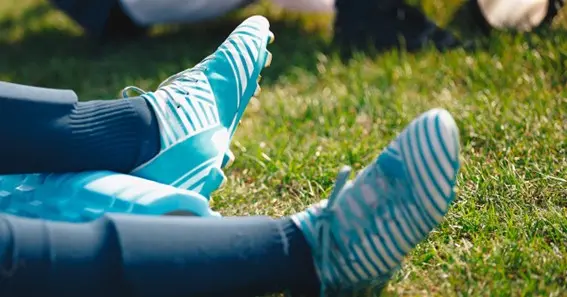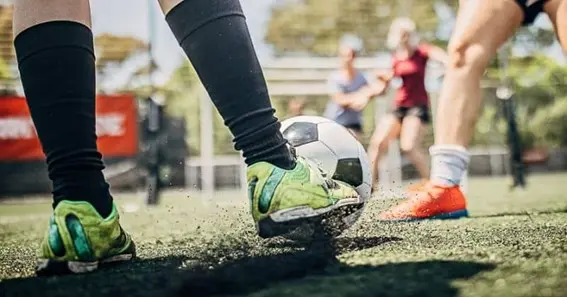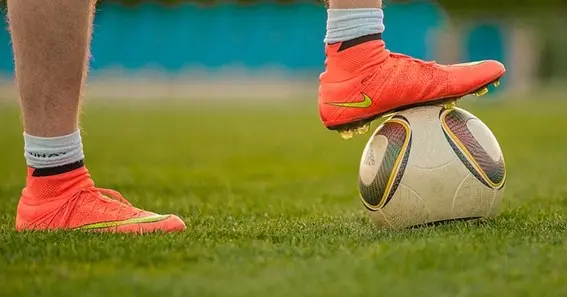What is the difference between baseball and football cleats? Baseball and football cleats differ in their design, structure, materials, and regulations. Parents, players, and sports fans often struggle with this subject. Cleats provide grip and stability for both games, helping you perform well. But baseball and football shoes are made, work, and are regulated differently. Here this article explain difference between baseball and football cleats and why choosing the correct type for each sport is crucial.
What is the Difference Between Baseball and Football Cleats?
Baseball and football shoes differ in how they provide grip and support on the field due to their demands. Baseball shoes are designed to move sideways and stop swiftly. Football cleats are designed for rough terrain and intense contact. Players must quickly shift directions when sprinting the bases, catching, or making plays in baseball. Cleats typically have a mix of metal and plastic spikes, making them easier to grip and move on grass and soil. However, football boots can survive strong hits and persistent running.
Understanding Baseball and Football Cleat Differences

The correct baseball and football cleats can affect your performance and safety. These shoes vary in structure, materials, traction, comfort, and restrictions to meet sport-specific needs. Here, we’ll explain the main difference between baseball and football cleats to help you choose the right pair.
Design and Structure
Due to their various moves and necessities, baseball and football shoes are created and assembled differently. Most baseball footwear is lighter and more flexible, with spikes for fast sideways movement and a low-cut style for mobility.
However, football cleats are more robust and come in low-cut, mid-cut, and high-top versions. High-top cleats best support your ankles, keeping you safe during tackles and sudden direction changes. Football cleat studs grab different surfaces. You can mold or remove the studs to suit different playing scenarios.
Materials Used
Due to their differing needs, baseball and football shoes use different materials. Baseball shoes are usually mesh or synthetic leather to keep players’ feet light and agile. Spikes are generally metal or hard plastic to grab grass and dirt.
Most football cleats are made of durable full-grain leather or synthetic blends. The designers chose these materials because they can withstand the game’s physical demands and last. The cleats have more vital areas to support you and withstand blows.
Traction and Grip
Traction and grip are vital in baseball and football, but cleats are constructed differently. Baseball spikes dig into the ground to give players a good grip for swift starts, stops and turns. Spike number and layout are determined to ensure stability during hitting and fielding.
However, football cleats grip grass and artificial grounds. The studs are longer and thicker to prevent players from slipping when moving swiftly during the game. Football shoes with studs are also designed to support tackles and runs. That should make the difference between baseball and football cleats more clear.
Comfort and Fit
Athletic shoes, like baseball and football cleats, must fit and feel comfortable. Tight baseball shoes promote agility and prevent blisters after extended wear. The design emphasizes comfort while moving swiftly.
However, football cleats emphasize support and safety. The fit is tighter and more padded to absorb shock and protect against accidents. Football is hard, so high-top cleats cushion your ankles. Both cleats must fit well to avoid discomfort and injury, but the exact fit depends on the sport.
Rules and Regulations
Baseball and football players of all levels must know shoe restrictions. Leagues determine baseball cleats. Metal spikes are preferred at higher levels, although some youth leagues only allow molded plastic spikes to reduce injury risk.
Football shoe length and stud type are also regulated. These rules ensure player safety and fairness. Detaching the studs lets football players alter cleats for playing conditions. However, stud length is strictly controlled to prevent player injury.
Maintenance and Care
Baseball and football shoes need proper care to last and perform well. Baseball shoes need frequent cleaning to avoid corrosion and dirt from metal spikes. Players should also adjust or replace loose spikes.
You must thoroughly clean your football shoes before each game, especially on muddy pitches. Check for damage and replace studs regularly. Stored in a cold, dry area, materials break down slower. Regular maintenance boosts performance and ensures cleat support and security.
Choosing the Right Cleats

Choosing cleats involves considering the playing field, position, and personal preferences. Baseball players use metal or plastic spikes based on level and field conditions. The option depends on position-specific elements, including outfielder speed and catch aid.
Football players must consider their function and style when choosing cleats. Linemen may choose high-top cleats for support, while wide receivers may choose low-cut cleats for speed. Players can find the right pair by trying on numerous pairs and consulting an expert.
Conclusion
Finally, difference between baseball and football cleats should be clear by now. From shape and materials to grip and laws, players’ performance and safety demands are considered when designing baseball and football cleats. Parents, teachers, and athletes must understand these differences to make sensible choices and optimize their game experience. This is all on difference between baseball and football cleats in details.
FAQ
Can you play football with baseball cleats?
Due to design modifications and grip issues, baseball cleats could be better for football. They may impair your ability and increase your risk of injury.
Can youngsters play baseball with metal spikes?
Many youth teams ban metal spikes because they damage players. Only molded plastic spikes were allowed. Check league rules before buying sneakers.
What goes into football cleats?
Football cleats are made of full-grain leather or synthetic blends to withstand rigorous play.
How often should football cleats be replaced?
Football cleats with worn studs or materials should be replaced. Check and mend your boots regularly to ensure safety and performance.
Does the level of play affect cleat rules?
Game regulations vary by group and level. Always examine your league’s rules to ensure compliance and effort.
Check out this insightful post what-is-wet-brain
Sources:
https://www.academy.com/expert-advice/different-types-of-cleats










